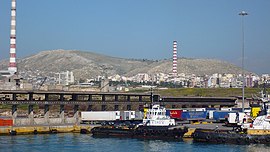Drapetsona
Drapetsona
Δραπετσώνα | |
|---|---|
 Port of Drapetsona | |
| Coordinates: 37°56.8′N 23°37.5′E / 37.9467°N 23.6250°E | |
| Country | Greece |
| Administrative region | Attica |
| Regional unit | Piraeus |
| Municipality | Keratsini-Drapetsona |
| Area | |
| • Municipal unit | 1.725 km2 (0.666 sq mi) |
| Elevation | 20 m (70 ft) |
| Population (2021)[1] | |
| • Municipal unit | 13,815 |
| • Municipal unit density | 8,000/km2 (21,000/sq mi) |
| Time zone | UTC+2 (EET) |
| • Summer (DST) | UTC+3 (EEST) |
| Postal code | 186 xx |
| Area code(s) | 210 |
| Vehicle registration | Z |
Drapetsona (Greek: Δραπετσώνα) is a coastal town, a suburb and a former municipality in the southwestern part of the Piraeus regional unit. Since the 2011 local government reform it is part of the municipality Keratsini-Drapetsona, of which it is a municipal unit.[2]
Geography
[edit]Drapetsona is situated on the north side of the inlet to the Port of Piraeus. The northwestern part of the port is on the territory of Drapetsona. Drapetsona lies 2 km west of Piraeus. The municipal unit has an area of 1.725 km2.[3] Its built-up area is continuous with those of neighbouring cities of Piraeus and Keratsini.
History
[edit]In 1805 the first church, Saint Dionysios was built. In the 1830s Drapetsona was constituted of people who moved from Greek islands and settled near Saint Dionysios church in the area called Vourla. In 1834 a part of the region was given to Piraeus in order to become a cemetery under the term of churches’ reconstruction. Also a great number of brothels was established in 1873 to the west of Saint Dionysios.[citation needed] After the 1922 Asia Minor Catastrophe there was a notable population increase.
Drapetsona was part of the municipality of Piraeus until 1950, when it became a separate community. It was elevated to municipality status in 1951.[4]
Since 19th century Drapetsona has become an important part of the Piraeus industrial area. The first major port facility was the Vasileiadis Shipyard, founded in 1898. Subsequently, other industries were established: a fertilizer factory, a plaster factory, a cement factory, a tannery and more recently installations of petroleum companies (Shell, Mobil, BP).

There are plans to redevelop a 64 hectares (160 acres) section of the Drapetsona seafront on the Saronic Gulf, the location of the former Greek Company of Chemicals and Fertilisers industrial complex, including the now abandoned Kanellopoulos Institute of Chemistry and Agriculture.[5] The plans call for utilisation of the area for tourism, business and water sports, including a maritime business centre, a convention centre, a technology museum and two marinas.[5]
"Drapetsona" is also the subject of a popular rebetiko song performed by folk singer Grigoris Bithikotsis in 1961 (Politia Vol.1).[6]
Historical population
[edit]| Year | Municipality |
|---|---|
| 1981 | 14,767 |
| 1991 | 13,094 |
| 2001 | 13,399 |
| 2011 | 13,968 |
| 2021[1] | 13,815 |
References
[edit]- ^ a b "Αποτελέσματα Απογραφής Πληθυσμού - Κατοικιών 2021, Μόνιμος Πληθυσμός κατά οικισμό" [Results of the 2021 Population - Housing Census, Permanent population by settlement] (in Greek). Hellenic Statistical Authority. 29 March 2024.
- ^ "ΦΕΚ B 1292/2010, Kallikratis reform municipalities" (in Greek). Government Gazette.
- ^ "Population & housing census 2001 (incl. area and average elevation)" (PDF) (in Greek). National Statistical Service of Greece. Archived from the original (PDF) on 2015-09-21.
- ^ "EETAA local government changes". Retrieved 29 June 2020.
- ^ a b Polyzos, G.; Maistrou, E.; Mavrokordatou, D.; Mahairas, G.; Belavilas, N.; Papastefanaki, L. (2001). Greek Company of Chemicals and Fertilisers: Past and Future of a Historic Industrial Complex (PDF) (in Greek). Athens: NTUA, Department of Architecture. pp. 144–149. Archived from the original (PDF) on 2021-04-13. Retrieved 2021-04-13.
- ^ (in Greek) Δραπετσώνα 1960: Η μάχη της παράγκας και η ιστορία ενός τραγουδιού. Pandiera.gr. Δεκ 13, 2016. Retrieved: 28 June 2018.
External links
[edit]- Municipality of Drapetsona
- TEE Drapetsonas (in Greek)


